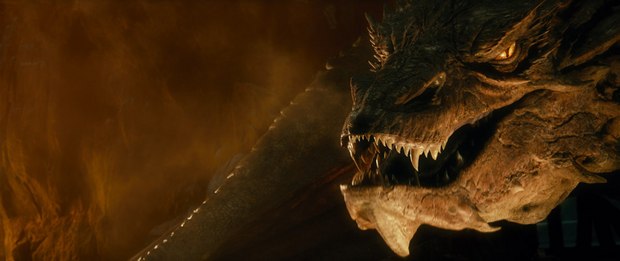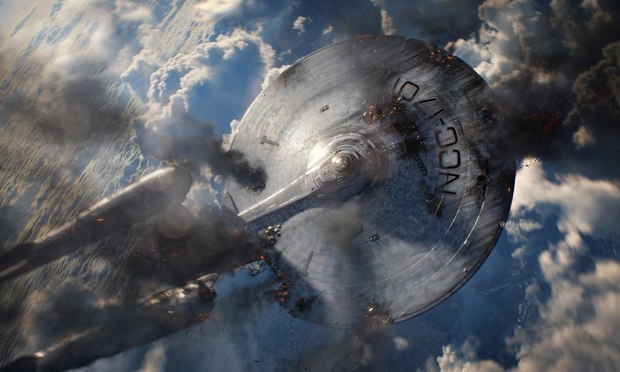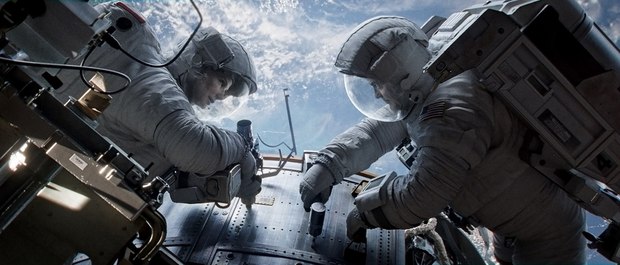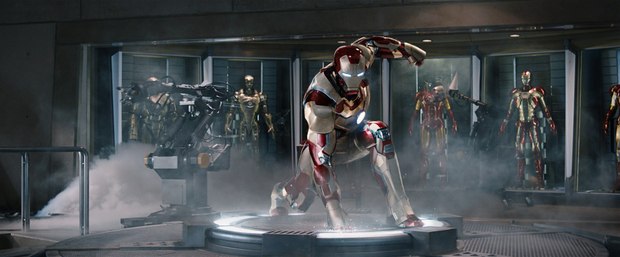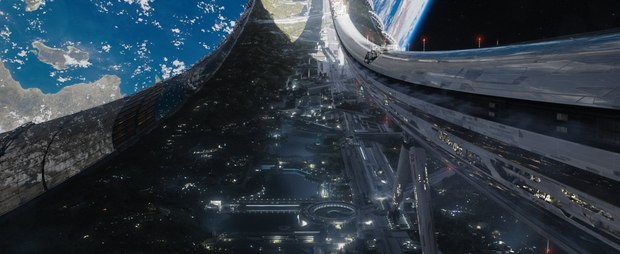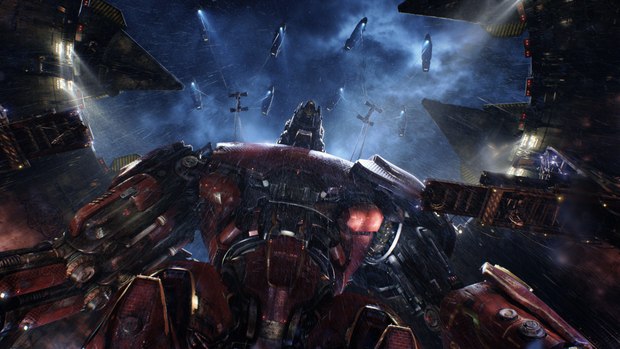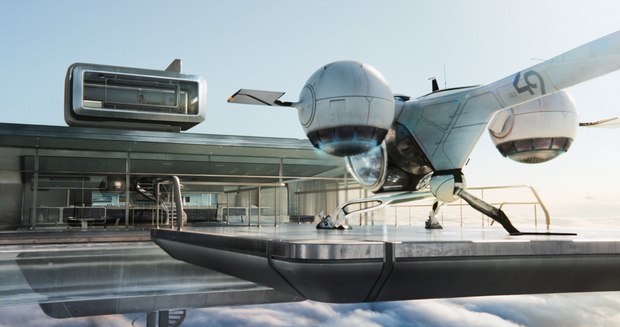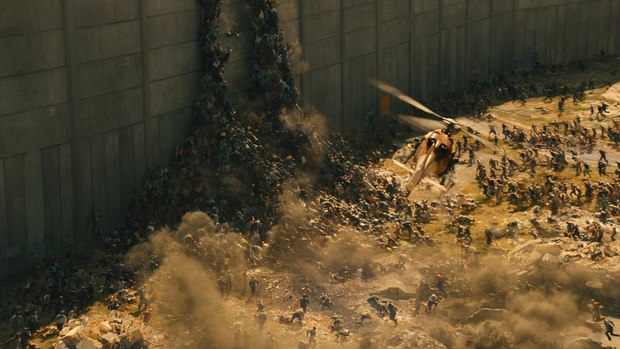10 contenders flaunt their “visual goods” at the annual Motion Picture Academy Oscar-nomination voting presentation.
Thursday night's annual Academy VFX Bakeoff stressed the combination of practical and digital effects in appealing to both old school and new school vets. Even though Gravity is the heavy Oscar favorite, all 10 contenders acquitted themselves well in their presentations. It was a well-crafted race between a zero-gravity space thriller, a menacing dragon, Jaegers vs. Kaiju, three dystopian adventures, a Star Trek reboot with Khan, uber train mayhem and two Marvel superhero stalwarts.
The Hobbit: The Desolation of Smaug
Weta Digital's Joe Letteri stressed Smaug, the dragon, of course (memorably voiced by Benedict Cumberbatch). It was all keyframed, emphasizing a courteousness that masked the raging psychotic personality. According to animation supervisor David Clayton, they needed complexity in the facial animation, focusing on tongue, eyes and lips. But the addition of two forefingers and thumb on his wings effectively gave him hands to gesture with.
Also on VFXWorld: Weta Breathes Fire into the Menacing Dragon of 'The Hobbit'
Additionally, there were 60 digital characters (including every Orc), and Peter Jackson wanted to shoot the spider fight dimensionally to take advantage of stereo, and so they choreographed the fight in free space and then dressed the trees with the webs. The barrel flume chase, the first set piece, was a combination of live-action and CG with 20 tons of digital water a second.
Star Trek Into Darkness
ILM's Roger Guyett touted matching real with virtual in keeping with J.J. Abrams' highly choreographed shot design for Star Trek Into Darkness. Challenges included creating a red volcanic planet, toxic Klingon cities and futuristic San Francisco and London. But they shot space action with IMAX large-format film cameras, which enhanced the impact.
Also on VFXWorld: Going Old and New School for ''Star Trek Into Darkness'
Gravity
For the blockbuster and game-changing Gravity, Framestore's Tim Webber emphasized the uniqueness and poetry of Alfonso Cuaron's vision and the studio's workflow, prevising and animating all of the CG space and weightlessness in advance and then later adding the faces of Sandra Bullock and George Clooney. They also had to join interior shots of the International Space Station and capsules, which were a combination of sets and CG extension. The 12-wire puppet rig, robotic-controlled cameras and Light Box added to a combination of new and old techniques in creating a special situation that points to the future of virtual production.
Also on VFXWorld: Reverse Engineering 'Gravity'
Iron Man 3
Christopher Townsend discussed Iron Man 3's multiple solutions and keeping it real on a very short post schedule. There were 41 CG suits with subtle performances. The new hero suit was in 500 shots, most of them CG, and was created by eight different companies (including Digital Domain, Weta Digital and Trixter). Now able to fly in individual shots, it was highlighted in the opening sequence with Trixter creating complex animation showcasing the full impact of the pieces as they fly and mechanically attach to Tony Stark.
Also on VFXWorld: Building a Better 'Iron Man 3'
Elysium
Image Engine's Peter Muyzers emphasized the eponymous world for Neill Blomkamp's Elysium. Image Engine focused on the overall ring structure (spokes and beams), and Whisky Tree created all the surface of Elysium: terrain, water bodies, mansions and other buildings, birds, and people. Image Engine also animated the Raven bird of prey assault vehicle.
Also on VFXWorld: Powering Up for 'Elysium'
The Lone Ranger
ILM's Tim Alexander touted the tremendous train work in Gore Verbinski's The Lone Ranger. They mostly adhered to "The 50% rule" in which they evenly divided CG and practical. John Frazier's team at Effects Works built two full-scale 1860s locomotives from the ground up because there were no existing period trains that could meet the requirements of the previs for both speed and safety. Powered by hidden twin diesel motors, the Jupiter train could run under its own power and pull a full contingent of train cars around a five-mile loop track that was custom-built for the movie. However, for the bravura 15-minute finale (naturally choreographed to "The William Tell Overture"), they went full-CG for both trains and environments.
Pacific Rim
ILM's John Knoll complimented Guillermo del Toro's Pacific Rim in suggesting that it's more about the monsters than the humans. The director emphasized character animation treating it like live action. There was above average shot complexity in the 1,566 shots. Most of the movie involved character interaction between robots and monsters with multiple layers of simulation on land and in the ocean with lots of atmospherics and intricate lighting. They also redid the ILM pipeline for greater efficiency involving Arnold, Katana, and Houdini. Arnold, in fact, played a big role in ray tracing several movies, including Gravity and Elysium.
Also on VFXWorld: 'Pacific Rim' and VFX Robot Porn
Also on VFXWorld: John Knoll Talks ILM, Disney, ‘Star Wars’ and Tough Times in the VFX Industry
Thor: The Dark World
For Thor: The Dark World, Jake Morrison described the great effort that went into building a more lived-in Asgard, work done by Double Negative. After shooting five hours of aerial footage off the coast of Norway, inspired by fjords, greenery and rocky precipices, they married photogrammetry with high-resolution landscape data to create a large section of photorealistic terrain that could then be populated with fantastical buildings and landscapes. Blur (the prologue attack) and Method (Aether crystalline projectiles) also contributed.
Oblivion
Digital Domain's Eric Barba explained the sense of '70s spectacle and beauty that went into Joe Kosinski's Oblivion. The biggest and most unique challenge was the Sky Tower. Because the director wanted it shot in camera Oscar-winning cinematographer Claudio Miranda (Life of Pi) came up with a modern version of front projection. They sent a small crew to Maui to shoot 15K photography footage that was blended seamlessly and retimed by Pixomondo (Hugo). The footage was then transformed into 10 sets of composites to match the storylines. They set up 21 projectors within a small sound stage. The sky sequences were projected onto a semi-circular screen surrounding the set, providing almost all of Miranda's lighting during principal photography.
Also on VFXWorld: Tackling Previs on 'Oblivion'
Also on VFXWorld: A New Post-Apocalyptic Look for 'Oblivion'
World War Z
ILM's Scott Farrar described the special zombie challenge of World War Z, one of the rare instances in which an expensive third-act reshoot paid off. Director Marc Forster wanted a breakthrough concept of speed and numbers. This necessitated a zombie rethink from MPC and Cinesite. Whether they were CG or live-action, an individual or a swarm, their movement would have to seamlessly blend. And it was important to decide when to use animated characters or performance. Their zombies were fast, cunning, and able to work on teams to forge streams, breach walls, form bridges like army ants. The driving force was the bite, like a fix to a junkie, so they devised the concept of leading with their teeth like an attack dog.
Also on VFXWorld: Turning Glasgow into Philadelphia for the Zombie Apocalypse of 'World War Z'
Also on VFXWorld: The Zombification of 'World War Z'
Stay tuned for the five nominees next Thursday.
--
Bill Desowitz is former senior editor of AWN and VFXWorld and the owner of Immersed in Movies (www.billdesowitz.com). He's also a columnist for Thompson on Hollywood at Indiewire and contributing editor of Animation Scoop at Indiewire. Desowitz is additionally the author of James Bond Unmasked (www.jamesbondunmasked.com), which chronicles the 50-year evolution of 007 on screen, featuring interviews with all six actors.
